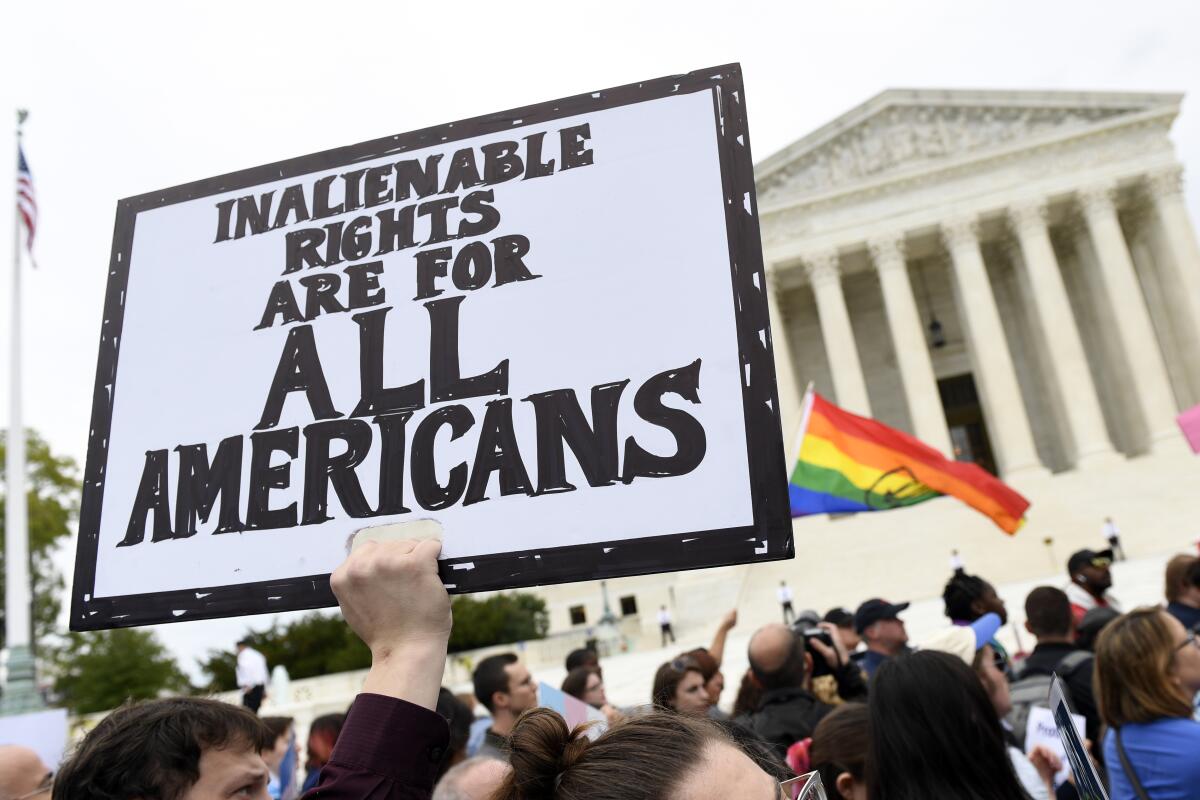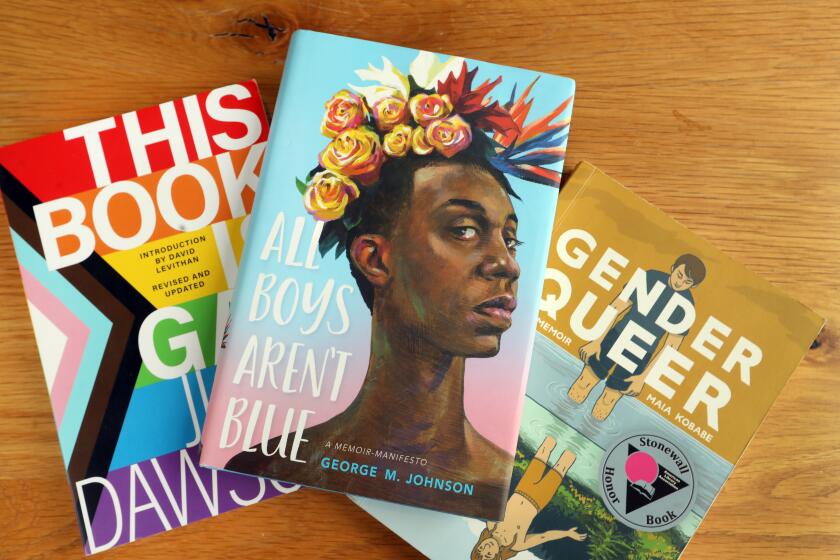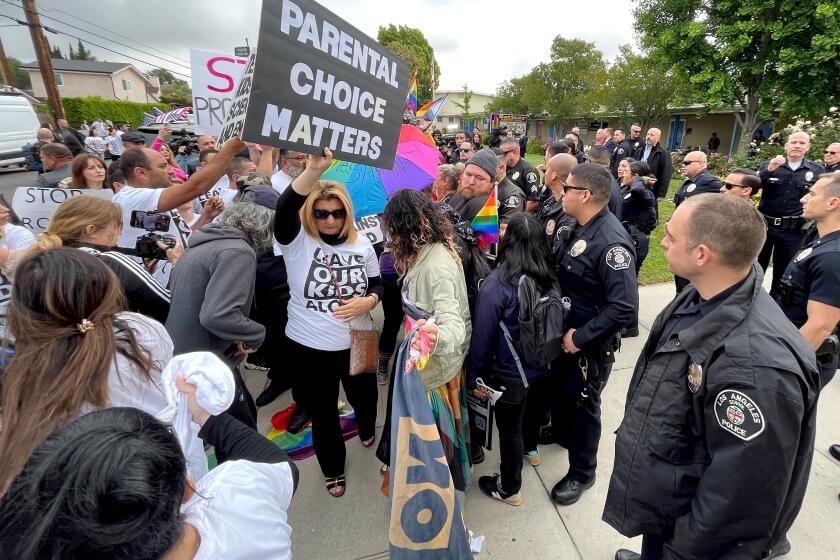LGBTQ+ students have become a political target. Know your rights in California

LGBTQ+ students in Southern California face a growing number of challenges as simmering hostility around LGBTQ+ rights boils over in various school districts.
In Los Angeles, a transgender teacherâs flag was burned and a few days later, a protest against Pride Day turned violent. In Glendale, a school board meeting about recognizing June as Pride Month led to a brawl between pro- and anti-LGBTQ+ demonstrators. In Temecula Valley, there was a heated debate over whether to include Harvey Milk and LGBTQ+ history in elementary school social studies. (The school board eventually voted to accept the state-approved curriculum.)
Nationally, more than 490 bills restricting LGBTQ+ rights have been proposed during this legislative session, by the American Civil Liberties Unionâs count. Although only one of these bills was proposed in California (and it was defeated), thereâs still confusion about the laws protecting LGBTQ+ students in the state.
According to the ACLU of Southern California, the nonprofit GLSEN advocacy group, an LGBTQ+ youth advocacy group and the California Education Code, LGBTQ+ students have extensive legal safeguards in California. Here are the main ones.
Library and LGBTQ+ advocates offer educators tips on how to respond when LGBTQ+ books come under attack in their school or district.
Schools cannot âoutâ you as LGBTQ+ without your permission
Your privacy is protected under the California and U.S. constitutions. You have control over who knows about your sexual orientation, gender identity or transgender status.
If your school district has a policy that forces school staff to âoutâ students who may be transitioning genders, even when the studentsâ object, you can report it to the U.S. Department of Education and the ACLU through their websites, and to your local county office of education. The Chino Valley Unified School District recently adopted such an outing policy, prompting California Atty. Gen. Rob Bonta to launch a civil rights investigation.
In limited cases, schools may disclose information about your LGBTQ+ status to your parents, but only with a valid reason and not as a form of punishment, harassment or discrimination.
âIt really depends on the individual student and situation,â said Ariana Rodriguez, staff attorney at the ACLU of Southern California. âThere are emergency circumstances or student physical safety where school districts have an obligation to protect students.â
If you face threats of being outed to your parents, seek advice and assert your right to privacy.
You are legally protected against harassment and discrimination
Schools that receive state or federal funding are required to protect LGBTQ+ students from harassment. And more broadly, the California education codeâs guarantee of equal rights requires schools to prevent bias and discrimination against LGBTQ+ pupils, including harassment based on sexual orientation, gender identity or expression.
What that means for schools is that they must have an anti-harassment policy and a clear process for filing complaints. Their staff must intervene if they witness discrimination, harassment or bullying. And they must use transgender and gender nonconforming studentsâ chosen names and pronouns, while also providing access to sex-segregated activities and facilities, such as sports programs and bathrooms, consistent with their gender identity.
Federal civil rights laws protect students from gender-based discrimination, as does the 14th Amendment to the U.S. Constitution, which ensures equal protection to everyone under the same laws.
Law enforcement declared an unlawful assembly after fighting broke out outside the Glendale Unified School District building.
You have extensive free-speech rights under state law
According to the ACLU of Southern California, the stateâs education code bars schools from punishing you for talking about being LGBTQ+ or discussing LGBTQ+ topics. This extends to expressing your opinion on buttons, bulletin boards, school newspapers, petitions and the like.
The ACLU provides examples of a number of other protections, including:
- If your school administrators let students wear clothing expressing their beliefs or political views, they cannot make you remove LGBTQ+-related clothing that does not otherwise violate school rules.
- Your school cannot prevent you from doing a class project about an LGBTQ+ topic or book, as long as it meets the assignment requirements.
- You have the freedom to express your sexual orientation and gender identity. This includes bringing a same-sex or gender nonconforming date to prom, wearing gender nonconforming clothing, and running for prom king or queen, regardless of your sex.
- You have the right to be yourself and dress in a gender nonconforming way for your school photos.
- You can create or participate in a Genders & Sexualities Alliances club at school to promote awareness, understanding and acceptance of different gender identities and sexual orientations.
- If you are transgender, you canât be forced to use separate bathrooms and locker rooms. If you prefer using a private space, you can request it. If your school does not have gender-neutral bathrooms, your school might let you use staff bathrooms, which are usually single-user restrooms required under state law to be labeled as gender-neutral.
Instruction must be unbiased and LGBTQ+-inclusive
Public schools in California cannot promote bias or discrimination based on sexual orientation, gender identity, expression or gender, according to the state education code. That includes sex ed classes.
Under the California Healthy Youth Act, teachers must include all genders, sexual orientations and family types in discussions about gender, sexual orientation or families. The law also bars sex ed classes from promoting bias against any gender or sexual orientation, and prohibits the use of religious materials and abstinence-only curriculums.
Finally, instructional materials and social science classes are required to include the contributions of LGBTQ+ Americans, such as Harvey Milk and Theresa Sparks.
The Temecula Valley Unified School District board voted 3 to 2 on May 16 to oppose adopting a new social studies curriculum for the districtâs 18 elementary schools.
If you feel bullied, harassed or discriminated against, what should you do?
The state Department of Education recommends reporting the bullying or discrimination to school officials and filing a complaint, following the procedures outlined by the local districtâs anti-harassment policy.
Complaints are confidential and can be filed by someone on behalf of the person who experienced the discrimination or harassment. The school is prohibited from retaliating against you for lodging a complaint.
If your school will not help you, contact GLSEN or the local ACLU chapter for help. Another option is filing a lawsuit with the aid of a lawyer from an LGBTQ+-friendly legal group. For example, Lambda Legal is a national organization that provides legal assistance and advocacy for LGBTQ+ individuals facing discrimination and other challenges.
You can also file a complaint with the California Department of Education, the U.S. Department of Education and your local human rights agency, which all have different filing processes.
For an overview of all your rights as a student, check out My School My Rights, an online resource that lists your rights and responsibilities within the California educational system.
Here are several other online resources and initiatives that support and empower LGBTQ+ students:
- Campus Pride focuses on creating safer, more inclusive college environments for LGBTQ+ students.
- YouthResource is a yearlong development and leadership program for LGBTQ+ youth of color, ages 14 to 24.
- It Gets Better Project provides videos and stories from LGBTQ+ individuals sharing their experiences and offering encouragement.
- The Point Foundation provides scholarships, mentorship and leadership development opportunities for LGBTQ+ students.
- CA Safe Schools Coalition works to create safe and inclusive K-12 schools for LGBTQ+ students through advocacy and resources.
Outside Saticoy Elementary School in North Hollywood, parents protesting a Pride Day assembly clashed with police and counterprotesters supporting LGBTQ+ rights and education.
How can you help your school improve its approach to LGBTQ+ students?
You can point your teachers, school administrators and school board members to multiple resources online that offer best practices for instructing LGBTQ+ students. Here are some of them.
The California Department of Educationâs website provides guidance on curriculum materials that are inclusive of LGBTQ+ youth, peer support or affinity clubs and organizations, safe spaces for LGBTQ+ students, and anti-bias training for school staff.
The Trevor Project, a nonprofit that provides crisis intervention and suicide prevention services to LGBTQ+ youth, offers LBGTQ+ students advice on how their schools can create safer spaces for them. It also has developed a model school district policy on suicide prevention, and it offers ally training to help educators learn about common LGBTQ+ words, the process of coming out and the difficulties LGBTQ+ individuals may face at school, home and in their community.
The projectâs Lifeguard Workshop, meanwhile, is a free online learning module with a video, curriculum and teacher resources for middle school and high school classrooms.
The American Psychological Assn. provides a Respect Online Course to give school staff the knowledge and skills to make schools safer and more supportive for LGBTQ+ students.
The California Teachers Assn. offers a teaching tolerance guide that discusses best practices for serving LGBTQ+ students.
Learning for Justice offers three professional development webinars for educators: LGBTQ Best Practices: Classroom Culture and Curriculum, Gender Savvy: Creating an Inclusive School Climate and Tool Kit for âBeing There for Nonbinary Youth.â
About The Times Utility Journalism Team
This article is from The Timesâ Utility Journalism Team. Our mission is to be essential to the lives of Southern Californians by publishing information that solves problems, answers questions and helps with decision making. We serve audiences in and around Los Angeles â including current Times subscribers and diverse communities that havenât historically had their needs met by our coverage.
How can we be useful to you and your community? Email utility (at) latimes.com or one of our journalists: Jon Healey, Ada Tseng, Jessica Roy and Karen Garcia.
More to Read
Sign up for Essential California
The most important California stories and recommendations in your inbox every morning.
You may occasionally receive promotional content from the Los Angeles Times.














